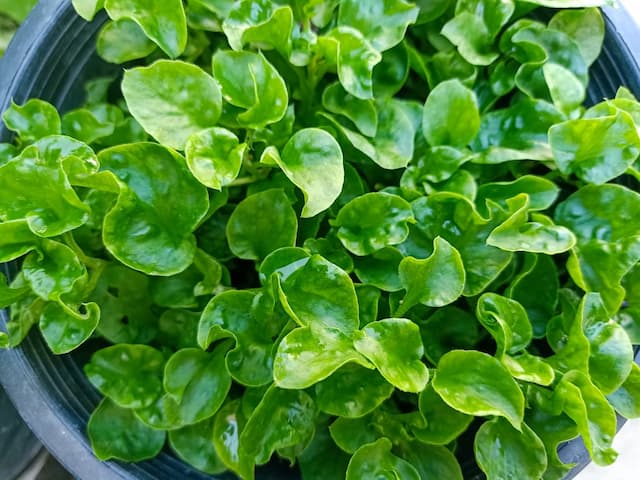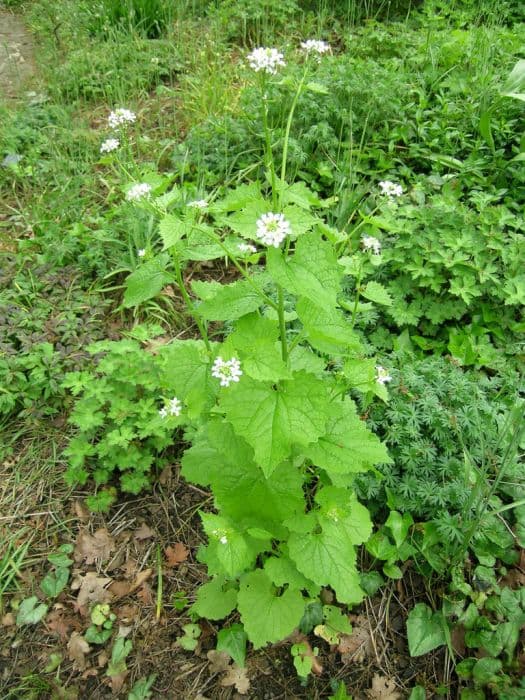Rock cress Aubrieta gracilis 'Kitte Purple'

ABOUT
Aubrieta gracilis 'Kitte Purple', also known as rock cress, is a vibrant perennial plant renowned for its colorful springtime display. This particular variety boasts a profusion of rich purple flowers that blanket its foliage. These blooms are small and dainty, with a typical four-petal structure that creates a dense, mat-forming appearance. The petals have a slightly ruffled edge, adding to their charm, and a prominent center that draws pollinators. The foliage of rock cress is equally appealing, with small, oval-shaped leaves that are slightly hairy and have a grayish-green hue. These leaves form a low-growing mound or carpet, which makes rock cress an excellent ground cover. The leaves remain evergreen in milder climates, providing visual interest even when the plant is not in bloom. Rock cress is well-loved for its ability to thrive in rocky, alpine environments or garden settings such as over walls or in rock gardens, where its cascading habit can be fully appreciated. Its dense flowering and evergreen leaves create a wonderful contrast against stonework or other plants, making 'Kitte Purple' a popular choice for gardeners looking to add a splash of color and texture to their landscapes.
About this plant
 Names
NamesSynonyms
Kitte Purple Rock Cress, Kitte Purple Aubrieta, Kitte Purple False Rockcress.
Common names
Aubrieta gracilis 'Kitte Purple'.
 Toxicity
ToxicityTo humans
Rock cress, which includes the variety Aubrieta gracilis 'Kitte Purple', is not commonly known to be toxic to humans. There is limited information available on the toxicity of rock cress to humans, and it is generally considered non-toxic. If ingested, it is unlikely to cause poisoning. However, as with any plant material, individual sensitivities or allergic reactions can occur, but such instances are rare. Therefore, it is still advisable to prevent ingestion, especially in large quantities, and to supervise children and pets around plants.
To pets
Rock cress, of which Aubrieta gracilis 'Kitte Purple' is a variety, is not commonly known to be toxic to pets, including dogs and cats. There is limited information regarding its toxicity to animals, and it is generally regarded as safe. No significant toxic effects are expected if pets ingest parts of this plant. Nonetheless, different animals can have individual sensitivities, and when consumed in large quantities, any plant material could potentially cause mild gastrointestinal upset. It is always recommended to monitor pets to prevent them from eating plants and to consult with a veterinarian if you suspect your pet is showing signs of distress after ingesting any plant material.
 Characteristics
CharacteristicsLife cycle
Perennials
Foliage type
Evergreen
Color of leaves
Green
Flower color
Purple
Height
4 inches (10 cm)
Spread
24 inches (61 cm)
Plant type
Herb
Hardiness zones
4
Native area
Southeastern Europe
Benefits
 General Benefits
General Benefits- Low Maintenance: Requires minimal care once established, making it ideal for gardeners looking for easy-to-care-for plants.
- Drought Tolerant: Can survive with limited water, suitable for dry or xeriscaped gardens.
- Ground Cover: Spreads effectively to cover bare spots, reducing weed growth and soil erosion.
- Attracts Pollinators: Flowers can attract bees and butterflies, supporting local ecosystems.
- Spring Bloomer: Provides vibrant early season color when many other plants are not yet in bloom.
- Rock Gardens: Ideally suited for rock gardens due to its ability to grow in rocky, less fertile soil.
- Edging Plant: Compact growth habit makes it a good choice for borders and edges in garden design.
- Evergreen: Some foliage remains throughout the year, offering winter interest in certain climates.
 Medical Properties
Medical PropertiesThis plant is not used for medical purposes.
 Air-purifying Qualities
Air-purifying QualitiesThis plant is not specifically known for air purifying qualities.
 Other Uses
Other Uses- Aubrieta can be used as a natural dye source for fabrics, imparting a range of purple hues that are derived from the pigments present in its flowers.
- The leaves of Aubrieta may be incorporated into natural insect repellents, as certain compounds found in the plant can deter pests.
- In garden design, Aubrieta is often used to create a colorful "living mulch," which can help reduce weed growth and maintain soil moisture.
- Aubrieta can be used in culinary presentations as an edible garnish, adding a splash of purple color to salads and desserts.
- The sprawling nature of Aubrieta makes it useful for planting in rock crevices, where it can help prevent erosion by stabilizing the soil with its root system.
- When dried, Aubrieta flowers can be used in potpourris, contributing both color and a subtle fragrance to the mix.
- In photography and painting, Aubrieta's vibrant blooms are used as a natural subject or backdrop, providing an intense pop of color.
- This plant can be added to compost piles as a green material, where it decomposes and contributes nutrients to the resulting compost.
- As a companion plant in the vegetable garden, Aubrieta can attract pollinators, potentially increasing the yield of crops.
- In crafting, the stems and flowers of Aubrieta can be used to create natural wreaths and floral arrangements.
Interesting Facts
 Feng Shui
Feng ShuiThe Aubrieta is not used in Feng Shui practice.
 Zodiac Sign Compitability
Zodiac Sign CompitabilityThe Aubrieta is not used in astrology practice.
 Plant Symbolism
Plant Symbolism- Persistence: Aubrieta, commonly known as Rock Cress, often symbolizes persistence due to its ability to grow in rocky, challenging conditions where other plants might not thrive.
- Strength: The plant's capability to grow in tough environments also lends it the symbolic meaning of strength.
- Resilience: Rock Cress is known for its resilience and ability to rebound from adverse conditions, much like it can in nature on the stony ledges and crevices where it grows.
- Beauty: With its 'Kitte Purple' flowers, Aubrieta represents beauty and the aesthetic pleasure of nature, bloomins profusely with vibrant colors in spring.
- Survival: The hardiness and survival skills of the Rock Cress in less than ideal soil conditions reflect a symbolism of survival and adaptation.
 Water
WaterRock Cress, commonly known as Aubrieta, requires moderate watering, especially during its growing season in spring and early summer. It’s best to water it when the top inch of soil feels dry to the touch, which typically amounts to once every week or two, depending on climate conditions. When watering, it's important to use a gentle flow to avoid disturbing the soil and roots, aiming for a deep watering that reaches all parts of the root zone. This might equate to about 1 gallon of water for an established plant in a garden setting. Reduce watering in the fall and winter when the plant is dormant.
 Light
LightRock Cress thrives in full sun to partial shade. The ideal spot for Rock Cress is one that receives at least 6 to 8 hours of direct sunlight daily, but it can also tolerate some light afternoon shade, especially in hot climates. Avoid placing it in deep shade, as this can lead to poor flowering and leggy growth.
 Temperature
TemperatureRock Cress is hardy and can tolerate a wide range of temperatures but grows best if the temperature stays between 60 and 75 degrees Fahrenheit. It can survive minimum temperatures down to about -20 degrees Fahrenheit and maximum temperatures up to 85 degrees Fahrenheit. However, prolonged exposure to temperatures outside of its ideal range may result in stress for the plant.
 Pruning
PruningPruning Rock Cress can encourage a more compact growth habit and enhance its flowering performance. Lightly trim the plant right after it has finished blooming, usually in late spring or early summer, to remove spent flowers and any leggy growth. An annual pruning like this will help maintain its shape and vigor, avoiding the need for more drastic pruning later on.
 Cleaning
CleaningAs needed
 Soil
SoilRock Cress requires well-draining soil with a slightly alkaline pH, typically between 6.5 and 7.5. A mix of regular garden soil, coarse sand, and compost would serve as an ideal growing medium to ensure good drainage and fertility.
 Repotting
RepottingRock Cress generally does not need frequent repotting as it is a low-growing perennial. Repotting can be done every 2 to 3 years to rejuvenate the soil and manage the spread.
 Humidity & Misting
Humidity & MistingRock Cress prefers a drier climate and does not require high humidity. Average room humidity is typically suitable for this plant, as excessive humidity can lead to fungal diseases.
 Suitable locations
Suitable locationsIndoor
Ensure light exposure and use well-draining soil.
Outdoor
Plant in full sun with well-draining soil; trim after flowering.
Hardiness zone
4-9 USDA
 Life cycle
Life cycleAubrieta gracilis 'Kitte Purple', commonly known as Kitte Purple rock cress, begins its life as a seed, which, when placed in well-draining soil and given ample sunlight and moisture, will germinate. The seedling emerges and develops a small rosette of leaves at the soil surface; during this juvenile phase, the plant establishes its root system. As the plant matures, it enters a vegetative state, spreading outwards with its evergreen leaves and preparing for the flowering stage. In early to late spring, the Kitte Purple rock cress produces vibrant purple flowers that attract pollinators and are essential for the reproductive phase. After pollination, the flowers develop into seed pods, which eventually dry out and release seeds for the next generation. In the winter or once flowering is complete, the plant may go dormant, reducing its above-ground activities until conditions become favorable again for growth.
 Propogation
PropogationPropogation time
Spring-Early Summer
The Aubrieta gracilis 'Kitte Purple', commonly known as false rock cress, is a perennial plant that can be propagated through several methods, with stem cuttings being the most popular due to its simplicity and effectiveness. To propagate by stem cuttings, choose a healthy, non-flowering shoot in the late spring or early summer. Cut a 3- to 4-inch (approximately 7.5 to 10 centimeters) length from the tip of the stem, ensuring at least a couple of leaf nodes are included. Remove the lower leaves and dip the cut end into rooting hormone to encourage root development. Plant the cutting into a well-draining soil mix, and keep it in a bright, indirect light location while maintaining consistent moisture. With proper care, roots should establish within a few weeks, at which point the cutting can be gradually acclimatized to outdoor conditions.



![Wallflower [Winter Orchid]](/_next/image?url=https%3A%2F%2Fplants-admin.emdemapps.com%2Fimages%2Fplants%2F%2Fimages%2F604b62b20ab9a.png&w=640&q=75)





